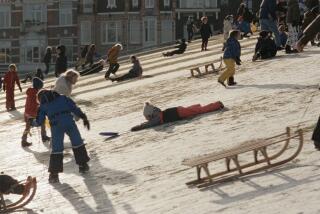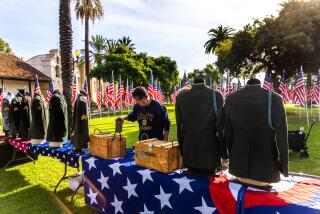A Soldier’s Images of Postwar Berlin
- Share via
WILLIAMSPORT, Pa. — For decades, former U.S. soldier Carl McDaniel’s black-and-white snapshots of postwar Berlin were filed in photo albums in his Pennsylvania home, destined to be passed on to grandchildren. Negatives sat in small boxes on a shelf in his home office.
Then, several years ago, he posted his pictures on a website where they caught the eye of officials at the Allied Museum in Berlin. Now, those photos are featured in an exhibit there commemorating the 60th anniversary of the end of World War II.
The exhibit, “Berlin 1945: A Private View,” is on display through Sept. 5. It is the first of its kind featuring only personal photos taken by soldiers, museum director Helmut Trotnow said.
“I’m 81 and I haven’t had any glory in my day,” says McDaniel, gray hair creeping out from underneath a black hat inscribed with “Berlin 1945-46” in gold letters. “And this story is giving me a little bit of glory.”
McDaniel has about 130 of the 200 photos he snapped in Berlin with a Kodak Retina camera he got by trading two packs of cigarettes. He lost track of most of the rest after sending them to his mother while he was in Berlin.
That’s no matter to Trotnow, who praises McDaniel’s work as a treasure trove of unusual private snapshots of life in Berlin in the years after Germany’s defeat.
Originally, the snapshots measured two inches by three inches. The museum paid to restore their quality and had the photos blown up in size. McDaniel has copies of the restored photos at home, and there’s a story behind each one.
“I go through these every night,” he says. “I know these pictures by heart.”
Many show the ruins left behind by Allied bombing of Nazi party headquarters and other strategic sites in Berlin. One photo depicts a little girl in a coat but no shoes staring at people who appear to be two Russian soldiers and an American soldier smiling and posing for another picture.
“I wish I realized then that the little girl didn’t have shoes, because if I knew, that girl would have [had] shoes,” McDaniel says.
Another favorite shows a woman and her daughter standing in front of the snow-covered rubble of a destroyed building. The mother, wearing a white jacket and a scarf wrapped around her head, offers a grin; the daughter wears a dark overcoat, the camera capturing the moment when her eyes are shut. She does not smile.
Did he date the daughter?
“Oh yeah, I went to see her,” he says nonchalantly.
He’d like to know if the woman is alive. “If she went to the museum and saw the picture, certainly she would do something about it,” he says.
It was relatively common then for soldiers to take pictures with cameras they got on the black market, Trotnow says, but through the decades, no one thought to ask Allied veterans who served in Berlin for their photographs. Most common are Russian photographs, but those pictures were controlled by the military, Trotnow says.
“Because of McDaniel’s website, we suddenly realized there was a personal view” of Allied life in Berlin, Trotnow said in an interview from his office in Berlin.
McDaniel has been an avid amateur photographer for most of his life. While in Germany in 1945 and 1946 with the 279th Station Hospital, he developed pictures himself using tools and chemicals he had from his assignment as an X-ray technician.
He returned home to Williamsport in 1946 and met and married his wife, Gladys, whom he still affectionately calls “Bunny.” They’ve lived in the same modest yellow house on a quiet tree-lined street for the last 53 years.
McDaniel has snapped countless pictures since then. But he calls the Berlin photos his “pride and joy.”
Several years ago, he bought scanners for his computers and posted his Berlin photos on a website. The page is now one of 74 sites he operates, mostly of his various pictures, grouped by subject matter.
In May 2004, McDaniel exchanged e-mails with Charles Huffer, who served with the Army in Berlin from 1961 to 1963. Huffer was working on a project comparing scenes of Berlin today with the past, and McDaniel sent a link to his website. Huffer said McDaniel told him his pictures would probably be destroyed after he died. Huffer also knew Trotnow from his work in Germany, and he told the museum director about McDaniel’s pictures.
Soon after, a museum official came to Williamsport to meet McDaniel and pick up the originals. About 50 of the photos are on display at the museum; others are also included in a book about the exhibit.
McDaniel has no plans to see the exhibit, even though the museum has offered to pay for his trip; he doesn’t like to deal with long airport lines. He also doesn’t like talking much about his experiences in the military, unless the subject is his photos.
“This is all about right here,” says McDaniel, waving his pictures in his hand.
McDaniel’s Berlin photos website: https://macswitch.tripod.com/berlin/index.html
More to Read
Sign up for Essential California
The most important California stories and recommendations in your inbox every morning.
You may occasionally receive promotional content from the Los Angeles Times.













